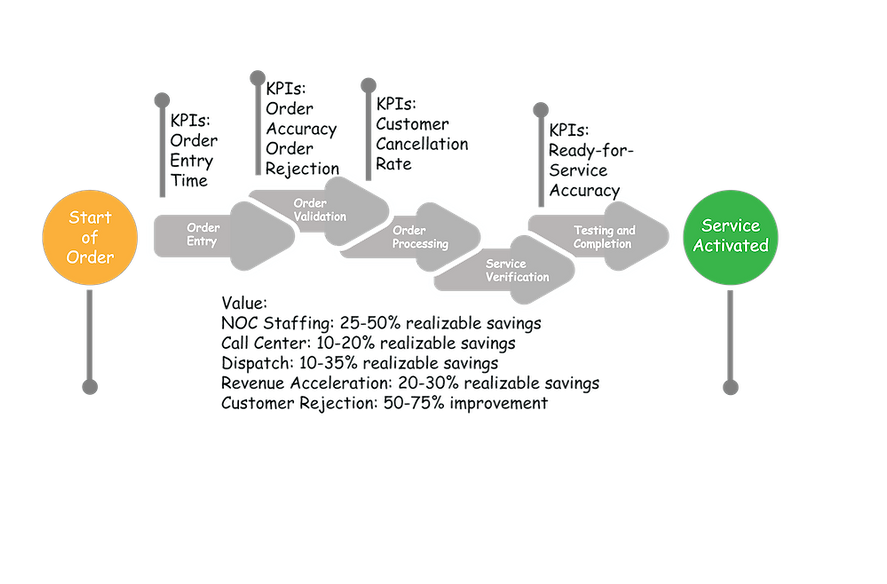
Lead-to-Order

The lead-to-order process is a lengthy complex process in all types of commercial industries. With internet or telecommunications service providers the the process is not completely straightforward.

Cart Abandonment
Digital and analog processes both contribute to order capture. The digital process entices prospective customers to a page or portal where orders can be captured. Abandonment rates vary but, in general, best-in-class companies see under 40% abandonment. BiC ISPs see much lower abandonment since internet is a basic service like water and power.

Customer Satisfaction
Digital processes enhance customer experience. Companies with chat options and on-line information and tailored options perform much better than companies without these.

Marketing Effectiveness
Marketing is critical to digital sales processes. Portals and carts must not be "IT owned" as so many web pages are; look and feel, simple, intuitive sales flow, and lucid product descriptions all drive up revenue/marketing spend. Portals integrated with product catalogs allows individualized pricing and terms.
Order-to-Service
The order-to-service process, incorporates many steps, pictured here linearly from order captured to service creation. In between, there are order validation, order processing, activating the order or service, completing and verifying the order and finally gaining customer acceptance. This overall stream from order entry to completion is a KPI that can be managed; the better this KPI, the happier the customer is going to be, the lower costs are going to be, and the better the business will be performing.

Lead-to-Cash
Lead-to-Cash is the critical KPI for all customer-focused business. Those that master the lead-to-cash process have lower customer acquisition costs, easier order fulfillment, low churn rates, high customer lifetime values and, of course, higher margins than companies that haven’t. We split Lead-to-Cash process into three consecutive parts.
We like this distinction because different back end IT systems contribute separately to the process improvement

Network Operations Ctr
Few things drive down brand image and customer satisfaction more than order errors, especially resulting in cancellation. Yet ISPs frequently take orders without knowing if and when service can be delivered. Poor order validation and order decomposition results in either order cancellation after the customer has ordered it, or unacceptably long order completion times. It is not uncommon for a "zero-touch" Ethernet circuit to take 50-70 days to complete.

Customer Satisfaction
If you order a computer on-line. You can configure it, personalize it, and know the exact date it will be delivered. Yes, for ISPs and Service Providers you frequently get none of these. Customer satisfaction is driven up when customers can see the prices, with options, understand the terms, and know when the ready-for-service date is. Even better when they can track it. BiC ISPs manage this by integrating their order portal, product catalog, service and resource inventory and their dispatch.

Dispatch
Three truck rolls to complete one order. This is not uncommon. Outside plant staff arrive on-site without the correct tools or parts. Several concurrent processes can lack integration resulting in a dispatch per process. Being expensive, dispatch errors can move the breakeven point to late in the contract, raising the risk of losing money.
Service-to-Cash

The Service-to-Cash process commences once the order is been accepted by the customer. Companies want revenue so this process is critical. Yet many companies do this poorly. The inability to bill is a major factor driving down the rate of new service offerings. If you can’t bill for it, you can’t offer it. If the billing system is configured for subscription services, but can’t calculate and bill on quantities then you can’t offer extra equipment for the service, like an extra router or two, or extra access points in your house. In a similar vein, if you have no trouble billing for quantities but can’t offer per minute billing for a subscription, then you must bill for subscription quantities like one month, one year, or two years

Competitive Flexibility
If the billing system is configured for subscription services, but can’t calculate and bill on quantities then you can’t offer extra equipment for the service, like an extra router or two, or extra access points in your house. In a similar vein, if you have no trouble billing for quantities but can’t offer per minute billing for a subscription, then you must bill for subscription quantities like one month, one year, or two years.

Customer Satisfaction
Being able to offer real time billing is a substantial advantage over companies that can only offer quantities like one month subscriptions. Customers are happy if they can quit anytime. Service providers offering near real-time charging takes on risk for the customer, and they appreciate it. If they have to subscribe to a service for a year or three, how do they get out of it if they need to. A customer prefers lower risk by having real time subscriptions.

Scale
Mediation is critical to dealing with large volumes of data. If you offer quantities of subscriptions, e.g. one month service or one year service, then handling 10,000 customers is not difficult since only 10,000 subscriptions need to be processed per month. On the other hand, if you were offering near-time charging, can you handle this volume: minutes per month per customer is a lot of data
